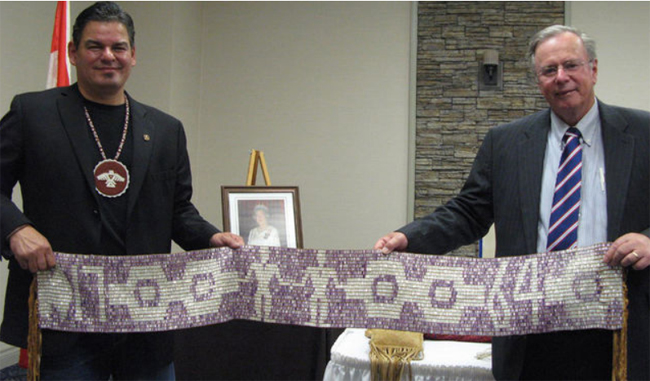Chief addresses club ‘elders’

By Maurice Switzer
Speaking to an audience he described as “Elders in your community”, Chief Isadore Day told members of the North Bay and District Canadian Club that Canada was founded on a treaty relationship with First Nations that began 250 years ago.
“There’s a lot of wisdom in this room,” said Day, the elected leader of Serpent River First Nation, located near Elliot Lake. “You are all treaty partners because your ancestors agreed to these relationships. “
Day carries the same traditional Anishinaabe name — Windawtegiwinini — as his grandfather, one of the signatories to the 1850 Robinson Huron Treaty. He also serves as Lake Huron Regional Chief for the Anishinabek Nation, a confederacy of 39 First Nations across Ontario.
“We haven’t had Indian wars in this country like those involving our neighbours to the south. Do you know why Canadians are so polite?” he asked about 80 people attending the club meeting at North Bay’s Best Western Hotel. “It comes from the original relationship between settlers and First Nations – this was high diplomacy.”
The treaty relationship began on Oct. 7, 1763, Day noted, with the issuing by Britain of the Royal Proclamation which recognized the concepts of Aboriginal land title and sovereignty. He said these principles were affirmed at the following July’s Treaty of Niagara Congress, when Sir William Johnson presented the leaders of 24 Great Lakes Indian nations the Covenant Chain Wampum Belt, a copy of which Day displayed for club members.
“The belts were a codified way to refer to promises. They have been used as evidence in the Supreme Court of Canada,” said Day, who recounted how he had presented the Wampum Belt to Stephen Harper at a reception for First Nations leaders at the prime minister’s official residence in Ottawa.
“We handed it to him backwards, indicating that the work promised in the belt had not been completed.”
That work, says Day, includes replacing the “race-based” Indian Act – that has created “institutional dependency” — with a relationship in which Canada respects First Nations’ self-determination and sharing in the use of land in a manner that reflects Anishinaabe law.
“The Earth is our Mother. We never understood the concept of selling or ceding land. The land does not belong to us; we belong to the land. We had a sacred obligation to take care of the land, and to share it with others.”
Day presented club president Ken Hastie with a gift of tobacco, which he said expressed his appreciation for the club’s hospitality and respect for the work it is doing to educate Canadians.
The North Bay and District Canadian Club has been in existence for 105 years. It was founded as a women’s organization, and guest speakers included Lucy Maude Montgomery, author of “Anne of Green Gables”, and Canadian women’s rights activist Nellie McClung.
The purpose of Canadian Clubs is “to organize a forum for the discussion of Canadian issues and the creation of a distinctly Canadian outlook”.


